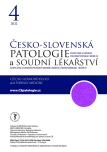The 5th edition of WHO classification of the urinary tract tumors – what is new?
Authors:
Kristýna Pivovarčíková 1,2; Tomáš Pitra 3; Ondřej Hes 1,2
Authors‘ workplace:
Šiklův ústav patologie LF UK a FN Plzeň
1; Bioptická laboratoř s. r. o., Plzeň, Česká Republika
2; Urologická klinika LF UK a FN Plzeň
3
Published in:
Čes.-slov. Patol., 58, 2022, No. 4, p. 207-211
Category:
Reviews Article
Overview
The 5th edition of WHO classification of the urinary tract tumors is only mildly edited version of the previous WHO classification (from year 2016). The most prominent changes are represented by modifications in the structure and concept of chapters and there are minor alterations in the nomenclature of some entities. Histological characteristics are still the gold standard for classification of urothelial tract neoplasms.
Keywords:
urothelial carcinoma – WHO 2022 classification – urinary tract
Sources
1. Moch H, Humphrey PA, Ulbright TM, Reuter VE. WHO classification of tumours of the urinary system and male genital organs. Lyon: International Agency for Research on Cancer (IARC); 2016.
2. Tsuzuki M, Compérat EM, Netto NR, et al. Tumours of the urinary tract. In: WHO Classification of Tumours Editorial Board. Urinary and male genital tumours. Lyon (France): International Agency for Research on Cancer; 2022. (WHO classification of tumours series, 5th ed.; vol. 8). https://publications.iarc.fr.
3. Kamoun A, de Reynies A, Allory Y, et al. A Consensus molecular classification of muscle- invasive bladder cancer. Eur Urol 2020; 77(4): 420-433.
4. Rosenthal DL, Wojcik EM, Kurtycz DFI. The Paris system for reporting urinary cytology. Switzerland: Springer; 2016.
5. Pivovarcikova K, Pitra T, Hes O. Aktuální pohled na močovou cytologii: Co přináší Pařížská klasifikace? Cesk Patol 2019; 55(1): 34-41.
6. Lopez-Beltran A, Cheng L, Andersson L, et al. Preneoplastic non-papillary lesions and conditions of the urinary bladder: an update based on the Ancona International Consultation. Virchows Arch 2002; 440(1): 3-11.
7. Amin MB, Comperat E, Epstein JI, et al. The Genitourinary Pathology Society update on classification and grading of flat and papillary urothelial neoplasia with new reporting recommendations and approach to lesions with mixed and early patterns of neoplasia. Adv Anat Pathol 2021; 28(4): 179-195.
8. Fransen van de Putte EE, Otto W, Hartmann A, et al. Metric substage according to micro and extensive lamina propria invasion improves prognostics in T1 bladder cancer. Urol Oncol 2018; 36(8): 361 e7- e13.
9. van Rhijn BW, van der Kwast TH, Alkhateeb SS, et al. A new and highly prognostic system to discern T1 bladder cancer substage. Eur Urol 2012; 61(2): 378-384.
10. Raspollini MR, Montironi R, Mazzucchelli R, Cimadamore A, Cheng L, Lopez-Beltran A. pT1 high-grade bladder cancer: histologic criteria, pitfalls in the assessment of invasion, and substaging. Virchows Arch 2020; 477(1): 3-16.
11. Amin MB, Edge SB, Greene FL, Byrd DR, Brookland RK, Washington MK. AJCC Cancer Staging Manual (Eighth edition). Chicago: Amerian Joint Committee on Cancer (AJCC); 2017.
12. Comperat E, Amin MB, Epstein JI, et al. The Genitourinary Pathology Society update on classification of variant histologies, T1 substaging, molecular taxonomy, and immunotherapy and PD-L1 testing implications of urothelial cancers. Adv Anat Pathol 2021; 28(4): 196-208.
13. Sheldon CA, Clayman RV, Gonzalez R, Williams RD, Fraley EE. Malignant urachal lesions. J Urol 1984; 131(1): 1-8.
14. Myers CE, Gatalica Z, Spinelli A, et al. Metastatic cancer of Cowper‘s gland: a rare cancer managed successfully by molecular profiling. Case Rep Oncol 2014; 7(1): 52-57.
15. Persson M, Andren Y, Mark J, Horlings HM, Persson F, Stenman G. Recurrent fusion of MYB and NFIB transcription factor genes in carcinomas of the breast and head and neck. Proc Natl Acad Sci U S A 2009; 106(44): 18740- 18744.
16. Lloyd RV, Osamura RY, Kloppel G, Rosai J. WHO Classification of Tumours of Endocrine Organs (4th Edition). Lyon: International Agency for Research on Cancer (IARC); 2017.
17. Jebastin JAS, Smith SC, Perry KD, et al. Pseudosarcomatous myofibroblastic proliferations of the genitourinary tract are genetically different from nodular fasciitis and lack USP6, ROS1 and ETV6 gene rearrangements. Histopathology 2018; 73(2): 321-326.
18. Acosta AM, Demicco EG, Dal Cin P, Hirsch MS, Fletcher CDM, Jo VY. Pseudosarcomatous myofibroblastic proliferations of the urinary bladder are neoplasms characterized by recurrent FN1-ALK fusions. Mod Pathol 2021; 34(2): 469-477.
19. Martin SA, Sears DL, Sebo TJ, Lohse CM, Cheville JC. Smooth muscle neoplasms of the urinary bladder: a clinicopathologic comparison of leiomyoma and leiomyosarcoma. Am J Surg Pathol 2002; 26(3): 292-300.
20. Babjuk M, Burger M, Compérat EM, et al. EAU Guidelines on non-muscle-invasive bladder cancer (TaT1 and CIS). Arnhem: European Association of Urology (EAU) Guidelines Office; 2022.
Labels
Anatomical pathology Forensic medical examiner ToxicologyArticle was published in
Czecho-Slovak Pathology

2022 Issue 4
Most read in this issue
- New insights in the new WHO classification of adult renal tumors
- Tumor lesions of penis and scrotum according to WHO classification 2022
- The changes and updates in the fifth edition of the WHO Classification of prostate tumors
- Key changes in WHO classification 2022 of testicular tumors
